Snail & Slug ID Chart
ERADICATE...kills snails & slugs dead!
 Cantareus aspersus (formerly Helix aspersa)
Cantareus aspersus (formerly Helix aspersa)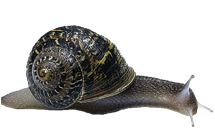
(Common Garden Snail, Brown Snail, Speckled Escargot) Geographic location
Throughout most of southern and eastern Australia as far north as the Atherton Tablelands QLD.
All towns cities and farmlands.
Features
Large shell, globose, imperforate, rounded whorls. Brown in colour with darker spiral bands, yellow speckles and flame like markings. Animal greenish brown body with pale dorsal stripe, foot greenish grey. Sized 25-40mm.
Food source
The garden snail is a herbivore and has a wide range of host plants (It feeds on plants only). It feeds on numerous types of fruit trees, vegetable crops, garden flowers, and cereals.
Importance and behaviour over summer
Common garden and agricultural pest, widespread throughout the world.
Cernuella virgata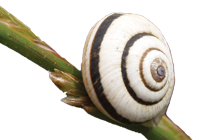
(Vineyard Snail, Common White Snail, Striped Snail)
Found throughout the agricultural districts of SA, the Victorian Mallee and Wimmera. Also occurs in WA, NSW and eastern Tasmania.
Features
Medium shell diameter between 10-20mm, coiled white shell with or without a brown band around the spiral, open, circular umbilicus. Under magnification regular straight, scratches/etchings can be seen across the shell.
Food source
Dead organic material but can severely damage young cereals, canola and pulse crops.
Importance and behaviour over summer
Contaminant of grain. Over summers off ground on plants, stubbles, posts etc.
Theba pisana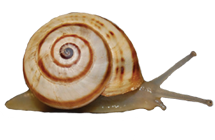
(White Snail, Italian Snail, Small Grey Snail)
Common along the coastal areas of SA. Also occurs in coastal areas of NSW, Victoria, WA and eastern Tasmania.
Features
Medium shell diameter between 10-20mm, coiled white shell with or without a brown band around the spiral. The umbilicus is narrow and half covered. The markings, when present, may be in the form of uninterrupted spiral bands, spiral dotted lines, or small radial smudges.
Food source
Green plant material and dead organic material. Can cause significant damage to emerging crops and pastures.
Importance and behaviour over summer
Contaminant of grain. Over summers off ground on plants, stubbles, posts etc. Especially found in green weeds.
Cochlicella barbara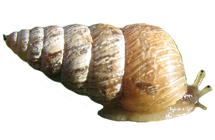
(Small Conical, Small Pointed Snail, Banded Conical Snail)
Occurs throughout SA, but is most abundant in the higher rainfall areas (>500mm). Also widely spread in NSW, Victoria and WA.
Features
Elongated conical shell, between 10-20mm high, with a width of 4-7mm wide. The oval aperture has a thin lip, and the narrow umbilicus is almost covered.
Food source
Green plant material and dead organic material. Recorded as a pest of lucerne.
Importance and behaviour over summer
Has caused grain contamination in the lower South East of SA. Often over summers in leaf litter at the soil surface or just below surface and under stones and stumps etc., but can be found on posts and vegitation.
Cochlicella acuta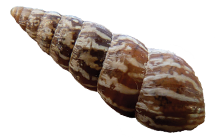
(Pointed Snail)
Highest numbers found on Yorke Peninsula in SA. Isolated populations also found in other parts of SA, Victoria, NSW & WA.
Features
Medium sized shell. Narrow elongate conical. Fawn, grey or brown in colour. Mature snails have a shell length of up to18mm. The ratio of the shell length to its diameter at the base is always greater than two.
Food source
Dead organic material. Never recorded feeding on crops or pastures.
Importance and behaviour over summer
Contaminant of grain. Over summers under stones and stumps, as well as on fence posts and vegetation.
Microxeromagna armillata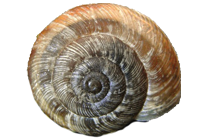
(Small Brown Snail, Citrus Snail)
Frankston, Victoria, Henley Beach, Adelaide, Sunraysia & Riverland.
Features
Small shell, with a low domed spire, narrow umbilicus, rounded whorls, strongly impressed sutures, thickened ring inside aperture, rugose radial growth corrugations. White to yellowish with spirally and radially arranged brown speckles and broken bands. Approx 7mm in size.
Food source
In Australia; citrus fruits and citrus leaf. Overseas; citrus fruits, citrus leaf and cereal plant material.
Importance and behaviour over summer
Can be quite common in citrus crops around some orchard in Southern Australia. This is one of the smallest hygromiid snails in Australia.
Deroceras reticulatum
(Grey Field Slug, Milky Slug)
Primarily throughout southern Australia, and in home garden and horticultural areas Australia wide.
Features
Medium sized lug with a very soft body and variable in colour. May be cream with darker web like pattern, or grey, beige, brown and white marbled pattern. Mucus is thick and white. Sized up to 50mm.
Food source
Living plant material including seeds, roots and seedlings, flower buds.
Importance and behaviour over summer
Found along streams, banks, gardens and around edges of creeks, swamps and ponds. This is the largest of the Deroceras species in Australia.
Milax gagates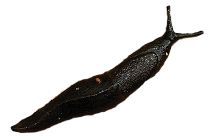
(Jet Slug)
Throughout South East Australia, Particularly Sydney, Berrima and Southern Highlands NSW.
Features
Medium sized dark brown, black or yellowish grey slug with strongly keeled tail and black horse shoe shaped pattern on mantle saddle. Sized approximately 40-50mm.
Food source
Living plant material including seeds, roots and seedlings, flower buds.
Importance and behaviour over summer
Commonly found throughout pastures, nurseries, wastelands and swamps under logs and rubbish.
Deroceras panormitanum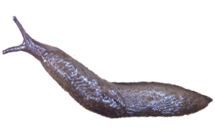
(Brown Field Slug, Caruana Slug, Sicilian Slug)
Southern & Eastern Australia. Native to SW Europe, but now widely distributed. Sydney, Brisbane and Newcastle area.
Features
Relatively small narrow, dark brown slug. Has a saddle shaped mantlewith very distinct "fingerprint" pattern. Pale border around pneumostome, clear mucus. Up to 30mm in size.
Food source
Living plant material including seeds, roots and seedlings, flower buds.
Importance and behaviour over summer
Often found under debris, around swamps and edges of ponds. One of the most widespread pest slugs in eastern Australia.
Limax maximus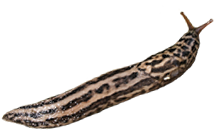
(Great Grey Slug, Tiger Slug, Leopard Slug, Great Striped Garden Slug)
Found throughout most of Australia, but not currently confirmed within the Northern Territory.
Features
Very large slug, light brown to beige background covered with numerous black spots or spots on the mantle saddle and longituinal black bands or spots down the tail. Thick clear mucus and size usually up to 120mm.
Food source
Dead plants, fungi and other slugs. Other foods sources include young crops.
Importance and behaviour over summer
Nurseris, gardens, agricultural land and pasture. Under wood, pots and rubbish. Generally solitary. Can lay up to 200 eggs at a time.
Arion hortensis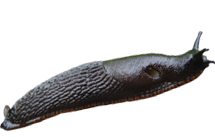
(Small Striped Slug)
Recorded in Tasmania.
Features
Orange sole, orange / yellow mucous.
Food source
Eats seedlings and other living plant material.
Importance and behaviour over summer
Lays eggs during spring / early summer. Tends to thrive on cultivated land.
Arion ater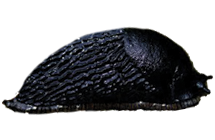
(Black Slug)
Found throughout South Australia, New South Wales and Victoria. Usually in cultivated habitats.
Features
Large slug up to 15cm long. Foot fringed with orange or yellow.
Food source
Rotting vegetation, fungi, manure and dead animals.
Importance and behaviour over summer
Lays eggs during spring / early summer. Not established as a serious pest in Australia.
Arion intermedius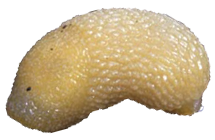
(Hedgehog Slug)
Found throughout all of Australia with the exception of the Northern Territory.
Features
Small slug approx 15-20mm long. Yellow to grey body, dark grey head, and mucous is pale to bright yellow.
Food source
Feeds on living plant materail and fungi.
Importance and behaviour over summer
Lays eggs during spring / early summer.
